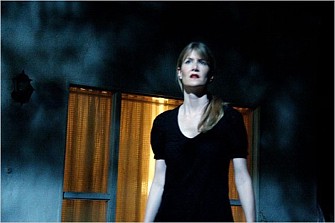
Knight at the Movies Archives
Two different posters for Inland Empire, neither of which will help the audience figure out what the hell is going on in David Lynch's
new movie; Laura Dern looking puzzled, distracted, anxious or all of the above -- typical for most of the movie
new movie; Laura Dern looking puzzled, distracted, anxious or all of the above -- typical for most of the movie
“I don’t really understand what I’m doing here,” Laura Dern says at one point in David Lynch’s new movie Inland Empire and
clocking in at almost three hours that is understandably going to be the reaction of a large majority of the audience at this
maddeningly frustrating movie. But the audience, at least the mainstream one, is obviously the furthest thing from Lynch’s mind.
Art house movie lovers, however will rejoice. With the surrealistic Inland Empire Lynch finally leaves the narrative long behind and
embraces his experimental, Eraserhead roots.
Increasingly, Lynch’s movies have pointed in this direction. As far back as 1997’s Lost Highway Lynch has been losing the battle
between trying to keep his movies on track with a discernable storyline and his more artistic tastes. Inland Empire (the title refers to
an area east of Los Angeles country) jumps immediately into the experimental arena with a series of surreal scenes – a prostitute in
a cheap hotel room bandying about S&M, a scene with a trio of human sized rabbits enacting a satire of sitcoms sans dialogue but
with the laugh track intact, etc., etc.. Abruptly, the sliver of a story appears. Actress Nikki Grace (Dern) is visited at her baronial
mansion by an ominous Polish accented woman (Lynch favorite Grace Zabriskie) who relates what she calls a Polish fairytale and
then warns Nikki not to take the role if offered in a movie called “On High in Blue Tomorrows.” But Nikki, after meeting with the
director Kingsley Stewart (Jeremy Irons) and her proposed co-star, the womanizing Devon Burke (Justin Theroux), decides to go
ahead. Once shooting begins she learns that “Blue Tomorrows” is actually a remake – the original two stars were murdered during
filming.
Sounds pretty normal, so far, doesn’t it? But, like the Polish lady, and depending on your taste, I’m either warning you or exciting
you with the news that before Lynch reaches the halfway point this story simply disappears into a spiraling vortex that seems to turn
on Nikki’s too strong identification with her role in the movie. Or maybe it’s the insane jealousy of Nikki’s husband and suspicions
that she and her co-star are having an affair. I thought the appearance of a roomful of women who do a desultory dance routine to
Little Eva’s “Loco-Motion” (and latter on Nina Simone’s “Sinner Man”) was merely a manifestation of Devon’s previous lovers come to
warn Nikki but later it seems that they are Polish prostitutes working the streets of Los Angeles. At one point, Nikki goes through a
door on the movie set and into another life. Devon disappears from the movie. As do the movie director and others. Later the life
sized rabbits reappear, as does Julia Ormond (barely recognizable) as a screwdriver wielding…what? Underneath, Lynch supplies his
usual soundtrack of industrial ambient menace – and like all his movies, a feeling of dread overwhelms everything. The syrupy
Mantovoni instrumentals used as a counterpoint just ramp up the dread (as intended).
There is more – much more – but you get the picture. Or rather, do not. “Can you please explain this movie to me?” a friend
asked, exasperated, after seeing Lynch’s last feature, 2001’s Mulholland Drive. I couldn’t. I know it’s the job of the film critic to at
least make the attempt – and to be sure, David Lynch is a good reason to keep members of our profession in business – but I
could no more ascribe Lynch’s motives in that one then I can explain why Laura Dern is a scared, frightened actress one moment
and a surly prostitute the next.
I can tell you that the movie is beautifully shot on the same kind of DV camera you can buy yourself at Best Buy, that Dern is
amazing – the way that Naomi Watts (who has a cameo) was amazing in Mulholland Drive. But the amazement comes from the
versatility of these actresses – not their ability to build and sustain a character (though both have done that many times in the
past). Dern plays a lot of different parts in the piece and sustains different moods in each. She’s thrillingly emotional – giving
Lynch an intensity that he obviously loves but so did Sheryl Lee in Twin Peaks: Fire Walk With Me and Watts in Mulholland. To what
end, I ask, is this intensity about? One applauds the work, appreciative of the technical bravura, the mystery and beauty of it, the
intensity of the emotion but like the movie itself, it’s not something that one will want to sit through again. To appreciate a work of
art is not necessarily the same thing as enjoying it.
clocking in at almost three hours that is understandably going to be the reaction of a large majority of the audience at this
maddeningly frustrating movie. But the audience, at least the mainstream one, is obviously the furthest thing from Lynch’s mind.
Art house movie lovers, however will rejoice. With the surrealistic Inland Empire Lynch finally leaves the narrative long behind and
embraces his experimental, Eraserhead roots.
Increasingly, Lynch’s movies have pointed in this direction. As far back as 1997’s Lost Highway Lynch has been losing the battle
between trying to keep his movies on track with a discernable storyline and his more artistic tastes. Inland Empire (the title refers to
an area east of Los Angeles country) jumps immediately into the experimental arena with a series of surreal scenes – a prostitute in
a cheap hotel room bandying about S&M, a scene with a trio of human sized rabbits enacting a satire of sitcoms sans dialogue but
with the laugh track intact, etc., etc.. Abruptly, the sliver of a story appears. Actress Nikki Grace (Dern) is visited at her baronial
mansion by an ominous Polish accented woman (Lynch favorite Grace Zabriskie) who relates what she calls a Polish fairytale and
then warns Nikki not to take the role if offered in a movie called “On High in Blue Tomorrows.” But Nikki, after meeting with the
director Kingsley Stewart (Jeremy Irons) and her proposed co-star, the womanizing Devon Burke (Justin Theroux), decides to go
ahead. Once shooting begins she learns that “Blue Tomorrows” is actually a remake – the original two stars were murdered during
filming.
Sounds pretty normal, so far, doesn’t it? But, like the Polish lady, and depending on your taste, I’m either warning you or exciting
you with the news that before Lynch reaches the halfway point this story simply disappears into a spiraling vortex that seems to turn
on Nikki’s too strong identification with her role in the movie. Or maybe it’s the insane jealousy of Nikki’s husband and suspicions
that she and her co-star are having an affair. I thought the appearance of a roomful of women who do a desultory dance routine to
Little Eva’s “Loco-Motion” (and latter on Nina Simone’s “Sinner Man”) was merely a manifestation of Devon’s previous lovers come to
warn Nikki but later it seems that they are Polish prostitutes working the streets of Los Angeles. At one point, Nikki goes through a
door on the movie set and into another life. Devon disappears from the movie. As do the movie director and others. Later the life
sized rabbits reappear, as does Julia Ormond (barely recognizable) as a screwdriver wielding…what? Underneath, Lynch supplies his
usual soundtrack of industrial ambient menace – and like all his movies, a feeling of dread overwhelms everything. The syrupy
Mantovoni instrumentals used as a counterpoint just ramp up the dread (as intended).
There is more – much more – but you get the picture. Or rather, do not. “Can you please explain this movie to me?” a friend
asked, exasperated, after seeing Lynch’s last feature, 2001’s Mulholland Drive. I couldn’t. I know it’s the job of the film critic to at
least make the attempt – and to be sure, David Lynch is a good reason to keep members of our profession in business – but I
could no more ascribe Lynch’s motives in that one then I can explain why Laura Dern is a scared, frightened actress one moment
and a surly prostitute the next.
I can tell you that the movie is beautifully shot on the same kind of DV camera you can buy yourself at Best Buy, that Dern is
amazing – the way that Naomi Watts (who has a cameo) was amazing in Mulholland Drive. But the amazement comes from the
versatility of these actresses – not their ability to build and sustain a character (though both have done that many times in the
past). Dern plays a lot of different parts in the piece and sustains different moods in each. She’s thrillingly emotional – giving
Lynch an intensity that he obviously loves but so did Sheryl Lee in Twin Peaks: Fire Walk With Me and Watts in Mulholland. To what
end, I ask, is this intensity about? One applauds the work, appreciative of the technical bravura, the mystery and beauty of it, the
intensity of the emotion but like the movie itself, it’s not something that one will want to sit through again. To appreciate a work of
art is not necessarily the same thing as enjoying it.
David Lynch Goes Back to Before:
Inland Empire
Expanded Edition of 1-24-07 Windy City Times Knight at the Movies Column
By Richard Knight, Jr.
Inland Empire
Expanded Edition of 1-24-07 Windy City Times Knight at the Movies Column
By Richard Knight, Jr.



